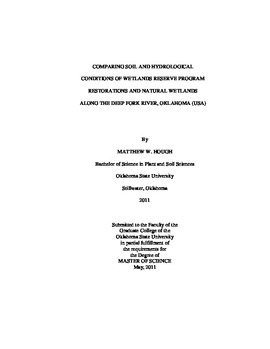| dc.contributor.advisor | Carter, Brian J. | |
| dc.contributor.author | Hough, Matthew W. | |
| dc.date.accessioned | 2014-04-15T22:06:06Z | |
| dc.date.available | 2014-04-15T22:06:06Z | |
| dc.date.issued | 2011-05-01 | |
| dc.identifier.uri | https://hdl.handle.net/11244/9331 | |
| dc.description.abstract | Wetlands Reserve Program (WRP) wetland restorations were compared to natural wetlands using hydrological and soil features to determine if WRP wetlands were similar to natural wetlands along the Deep Fork River in central Oklahoma. Hydrological comparisons between WRP and natural wetlands were conducted utilizing water-table levels and soil moisture values. Soil properties utilized in the comparison of WRP and natural wetlands included data gathered from soil profile descriptions to indicate differences in morphological features, soil nutrient and chemical properties, and levels of sediment accumulation. Data were correlated to determine trends that indicated further differences between WRP and natural wetlands. Water-table levels in WRP wetlands were determined to fluctuate more than natural wetland water-table levels. Natural wetland soils were determined to be more frequently saturated and inundated than WRP wetland soils. Differences in hydrological features between WRP and natural wetlands were a result of water table management and agricultural and restoration practices in WRP wetlands. Soil profile descriptions indicated some morphological differences between wetland types, and soil organic matter and certain nutrients were lower in WRP wetlands than in natural wetlands. Sedimentation rates were similar between wetland types. Differences in soil characteristics between WRP and natural wetlands were likely a result of the decreased soil maturity and history of disturbance in WRP wetlands. Overall, soil characteristics of WRP wetlands indicated that these sites were becoming more similar to natural wetlands. The differences in WRP and natural wetlands that existed may indicate differences in functions. However, further study is warranted to establish how differences between wetland types may affect functioning and before changes to WRP wetland implementation should be applied. | |
| dc.format | application/pdf | |
| dc.language | en_US | |
| dc.publisher | Oklahoma State University | |
| dc.rights | Copyright is held by the author who has granted the Oklahoma State University Library the non-exclusive right to share this material in its institutional repository. Contact Digital Library Services at lib-dls@okstate.edu or 405-744-9161 for the permission policy on the use, reproduction or distribution of this material. | |
| dc.title | Comparing Soil and Hydrological Conditions of Wetlands Reserve Program Restorations and Natural Wetlands Along the Deep Fork River, Oklahoma (Usa) | |
| dc.type | text | |
| dc.contributor.committeeMember | Davis, Craig A. | |
| dc.contributor.committeeMember | Bidwell, Joseph R. | |
| dc.contributor.committeeMember | Hickman, Karen R. | |
| osu.filename | Hough_okstate_0664M_11330.pdf | |
| osu.college | Agricultural Sciences and Natural Resources | |
| osu.accesstype | Open Access | |
| dc.description.department | Department of Plant and Soil Sciences | |
| dc.type.genre | Thesis | |
| dc.subject.keywords | hydrology | |
| dc.subject.keywords | oklahoma | |
| dc.subject.keywords | restoration | |
| dc.subject.keywords | soil | |
| dc.subject.keywords | wetland | |
| dc.subject.keywords | wetlands reserve program | |
